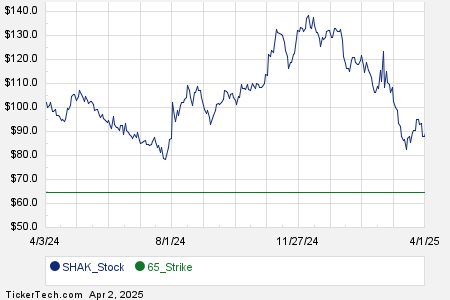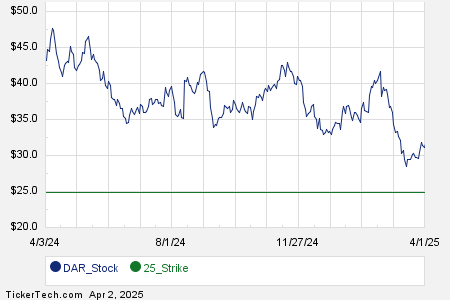Dollar Index Declines Following Weak US Job Reports and Economic Concerns
The dollar index (DXY00) has decreased by -0.10%. After an initial advance, the dollar turned lower, influenced by weaker-than-expected US job openings and ISM reports. Additionally, the dollar faces pressure from concerns that US tariffs may hinder economic growth.
Initially, the dollar rose as concerns over US tariffs impacted equity markets, leading to increased demand for safe-haven assets. Dovish inflation reports from the Eurozone also contributed to a stronger dollar against the euro.
The Barchart Brief: Your FREE insider update on the most significant news stories and investing trends, delivered midday.
In economic data released today, US job openings fell by -194,000 in February to 7.568 million, missing expectations of 7.658 million. The ISM manufacturing index for March declined by -1.3, reaching a 4-month low of 49.0 and falling short of the anticipated 49.5. In contrast, the ISM prices paid sub-index increased by +7.0 to reach a 2-3/4 year high of 69.4, surpassing expectations of 64.6. Construction spending in the US for February rose by +0.7% month-over-month, exceeding forecasts of +0.3%.
This week’s market focus will include the March ADP employment change expected to rise by +120,000, the ISM services index anticipated to decrease by -0.5 to 53.0, and the nonfarm payrolls for March projected to add +138,000 jobs. The unemployment rate is expected to remain unchanged at 4.1%. Additionally, average hourly earnings for March are anticipated to match February’s figures at +0.3% month-over-month and +4.0% year-over-year. Fed Chair Powell is also scheduled to address the Society for Advancing Business Editing and Writing Conference on the economic outlook this Friday.
The markets currently indicate a 21% probability of a -25 basis point rate cut following the May 6-7 FOMC meeting.
EUR/USD (^EURUSD) has seen a decrease of -0.09%. The euro is under pressure after economic news from the Eurozone revealed a downward revision of the March S&P manufacturing PMI and a slower-than-expected rise in consumer prices, both dovish indicators for ECB policy. Additionally, lower yields on German bunds have weakened the euro’s interest rate differential, as the 10-year bund yields have dropped to a 3-1/2 week low. However, the euro’s losses were somewhat offset by the Eurozone’s February unemployment rate unexpectedly falling to a record low.
The March Eurozone S&P manufacturing PMI was revised downward by -0.1, now at 48.6, down from the previously reported 48.7. The consumer price index (CPI) for March rose by +2.2% year-over-year, precisely aligning with expectations and marking the smallest increase in five months. The March core CPI increased by +2.4% year-over-year, which was below expectations of +2.5% and the weakest growth in three years.
The Eurozone’s February unemployment rate unexpectedly decreased by -0.1, reaching a record low of 6.1%, indicating a stronger labor market than the anticipated hold at 6.2%.
Swaps are forecasting a 79% chance of a -25 basis point rate cut by the ECB at the upcoming April 17 policy meeting.
USD/JPY (^USDJPY) is down by -0.55%. The yen strengthened today following better-than-expected Japanese economic data regarding March manufacturing activity and a decrease in the February jobless rate, signaling strength in Japan’s economy. A decline in Treasury note yields also supports the yen’s position. The yen gained additional ground after the Bank of Japan (BOJ) announced a cut in long-term bond purchases for Q2, marking the first reduction in a year.
The February jobless rate in Japan unexpectedly declined by -0.1 to 2.4%, indicating a stronger labor market than anticipated. March’s Jibun Bank manufacturing PMI was revised up by +0.1, resulting in a reading of 48.4, while the Q1 Tankan large manufacturing business conditions index fell by -2 to 12, meeting expectations. Conversely, large non-manufacturing business conditions unexpectedly improved by +2 to a 33-year high of 35, stronger than expectations of no change.
In precious metals, June gold (GCM25) is up +6.30 (+0.20%), while May silver (SIK25) is down -0.241 (-0.70%). The market for precious metals is mixed, with gold reaching a contract high and nearest-futures gold (J25) touching a record high of $3,149.50 per ounce. Concerns regarding trade policies continue to drive demand for safe-haven investments like gold ahead of the implementation of new tariffs. Lower global bond yields are also supportive of precious metal prices. Geopolitical risks, particularly in the Middle East, have heightened demand, as Israel has resumed airstrikes in Gaza after a ceasefire and the US has intensified strikes on Houthi rebels in Yemen. Fund buying activity has also been robust, with long positions in gold ETFs reaching a 1-1/2 year high on Monday.
Silver lost ground today after initially rising, as concerns about industrial metals demand grew following a larger-than-expected fall in February job openings and a significant contraction in the March ISM manufacturing index. Market sentiment around US tariffs potentially igniting a trade war that could stifle economic growth and industrial metals demand has further pressured silver prices.
On the date of publication, Rich Asplund did not have (either directly or indirectly) positions in any of the securities mentioned in this article. All information and data in this article is solely for informational purposes. For more information, please view the Barchart Disclosure Policy here.
More news from Barchart
The views and opinions expressed herein are the views and opinions of the author and do not necessarily reflect those of Nasdaq, Inc.


